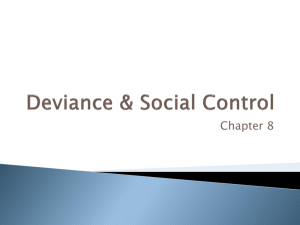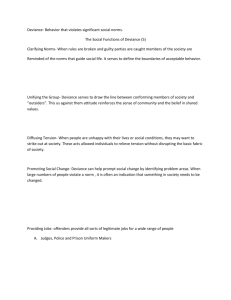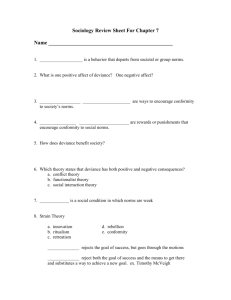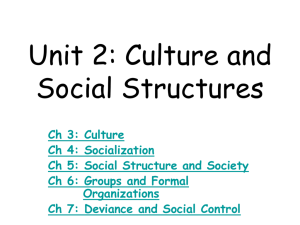SA 2nd shift - The life of a Speech
advertisement
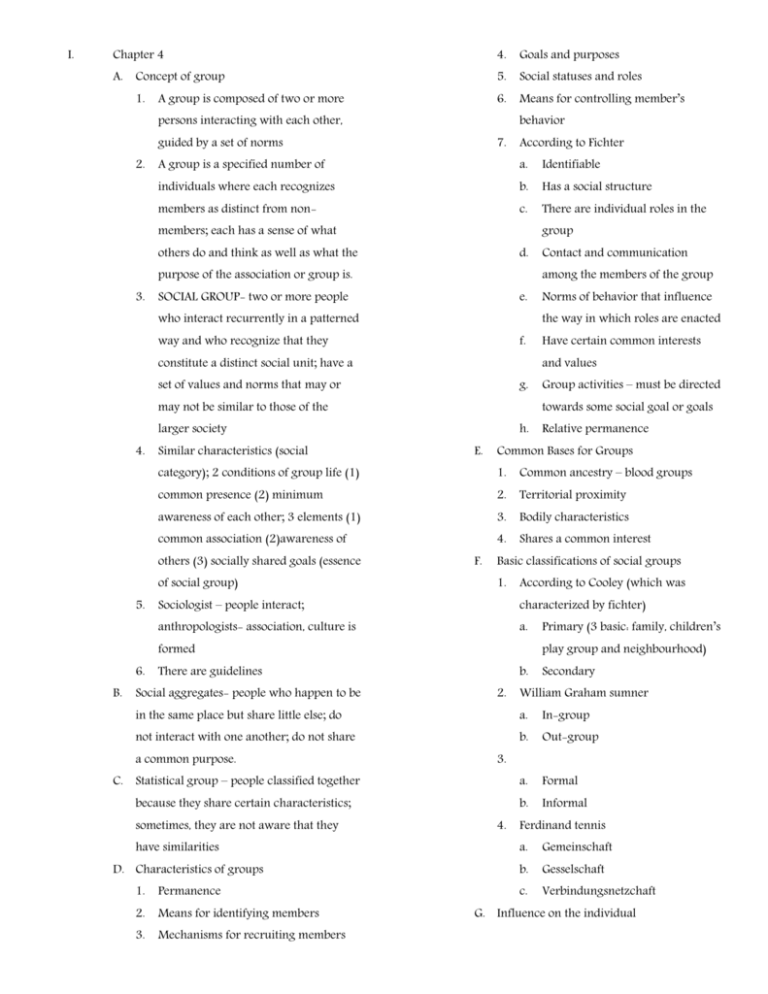
I. Chapter 4 4. Goals and purposes A. Concept of group 5. Social statuses and roles 1. 6. Means for controlling member’s A group is composed of two or more persons interacting with each other, behavior guided by a set of norms 2. 7. According to Fichter A group is a specified number of a. Identifiable individuals where each recognizes b. Has a social structure members as distinct from non- c. There are individual roles in the members; each has a sense of what group others do and think as well as what the d. purpose of the association or group is. 3. among the members of the group SOCIAL GROUP- two or more people e. who interact recurrently in a patterned f. constitute a distinct social unit; have a g. may not be similar to those of the h. E. Common Bases for Groups 1. Common ancestry – blood groups common presence (2) minimum 2. Territorial proximity awareness of each other; 3 elements (1) 3. Bodily characteristics common association (2)awareness of 4. Shares a common interest of social group) F. Basic classifications of social groups 1. According to Cooley (which was Sociologist – people interact; characterized by fichter) anthropologists- association, culture is a. formed B. Relative permanence category); 2 conditions of group life (1) others (3) socially shared goals (essence 6. Group activities – must be directed towards some social goal or goals larger society 5. Have certain common interests and values set of values and norms that may or Similar characteristics (social Norms of behavior that influence the way in which roles are enacted way and who recognize that they 4. Contact and communication play group and neighbourhood) There are guidelines Social aggregates- people who happen to be Primary (3 basic: family, children’s b. 2. Secondary William Graham sumner in the same place but share little else; do a. In-group not interact with one another; do not share b. Out-group a. Formal b. Informal a common purpose. 3. C. Statistical group – people classified together because they share certain characteristics; sometimes, they are not aware that they have similarities D. Characteristics of groups 1. Permanence 2. Means for identifying members 3. Mechanisms for recruiting members 4. Ferdinand tennis a. Gemeinschaft b. Gesselschaft c. Verbindungsnetzchaft G. Influence on the individual 1. Social facilitation – an individual is 6. stimulated by the presence of others 2. spheres Social inhibition- presence of others L. blocks or retards one’s performance Today 1. Group pressure disconnectedness that is supposed to be 4. Group discussion present among workers in capitalistic 1. societies Norms develop and conformity occurs 2. Ritualism because individuals seek others with 3. Incompetence similar characteristics a. Reward or compensation incompetence; bureaucracy 3. Social acceptance rewards good work with Linkages in groups advancement employees keep 1. Sociometry- study the mix feelings that rising up through the pyramid of persons have about one another authority until they finally reach a Sociogram- graph in which these job for which they are not social choices or ties are diagrammed qualified 3. Social networks Dimensions of groups 1. Size 2. Structure (a) formal (b)informal; II. Chapter 5 A. Social interaction 1. Refers to the process by which people act and react in relation to others bureaucracy- formal, rationally 2. Herbert Blumer- “human beings organized and highly organized social interpret or define each other’s actions. structure with clearly defined patterns This means that our response to of activity in which, ideally, every someone’s behavior is based on the series of actions is fundamentally meaning we attach to the other’s related to the organization’s purpose actions. Reality is shaped by our 3. Nature of goals perceptions, evaluation and definition 4. Identifiability of members of such reality. 5. Cohesiveness – degree to which 6. K. Peter Principle – level of 2. 2. J. Alienation – sense of loss and 3. H. Why do people conform? I. Distinction between public and private 3. Process whereby people accomplish members of a group cooperate some aim and is always directed Leadership styles toward specific other. Weber’s model of bureaucracy B. Frameworks used in interaction 1. Clear-cut division of labor 2. Hierarchical delegation of power and which people interpret and evaluate responsibility the social context to select appropriate 3. Rules and regulation attitudes and behavior 4. Impartiality 2. Presentation of the self 5. Employment based on technical 3. Negotiated order – refers to a social qualifications 1. Defining the situation – process by structure that derives its existence from the social interactions through which 1. Objective existence people define and redefine its character 2. Society is also affecting the behavior of C. Types many creative people 1. Cooperation 3. 2. Conflict 3. Competition 4. Negotiation of everyday, common-sense 5. Coercion understandings that people have of the shape reality through social interaction 4. D. Elements 1. 2. 5. Networks – web of relationships that a. Ascribed connects an individual to many other b. Inscribed people; set of interdependent links or c. Master ties among individuals that constitutes Roles the web of family, neighbourhood, a. Role strain- people find it difficult circles of friends and acquaintances to perform the role expected of with whom they interact in the course them of their lives. Role conflict – occurs when the G. What influences social interaction? carrying out of one role 1. Goals and motivations automatically results in the 2. Situation or context violation of another 3. Norms c. Role exit- letting go H. Types d. Role ambiguity- unclear 1. Non verbal behavior expectations associated with 2. Unfocused particular social positions 3. Focused Symbolic interaction 4. Group 1. Meaning 5. Social organization refers to the 2. Observing (through social interaction) relatively stable patterns of social 3. Mead stressed that human interaction relationships among individuals and is ruled by cultural meaning and many groups in society. cultural meanings are symbolic 4. 5. Human interaction is a process of Chapter 6 A. The long and complicated process of social interaction through which the child learns symbols the intellectual, physical and social skills Dramaturgical approach- people think needed to function as a member of society performers 6. III. acting on the basis of meaningful how they become active role F. Enthometodology- refers to the study world around them Status b. E. Process by which individuals creatively Impression management- they way B. A process of mutual influence between a person and his fellowmen C. Two points where one tries to control what others 1. Objective think about them 2. Subjective Social construction of reality 3. Looking glass self D. Process which goes on in the individual E. F. while he is adapting to the people around 4. Conflict theory and socialization him. 5. Social and biological conflict Importance L. Agencies 1. Vital to culture 1. Family 2. Vital t personality 2. Peer groups 3. Vital to sex role differentiation 3. Media Social frame of reference – fichter social 4. School experience is (1) common to all human 5. Workplace beings (2) unique to each person and (3) 6. Desocialization – strip away the self- specific to a particular culture and society images and perspectives that are the G. Social learning 1. Response – interaction between the learner and the thing learned results of previous socialization M. Stages 1. H. Subprocesses of social learning J. Infancy Imitation b. Early childhood 2. Suggestion c. Play stage 3. Competition d. School age 4. Essential prerequisites – contact and e. Adolescence communication f. Young adulthood Symbol- anything that is used to g. Middle adulthood represent something h. Old age Components 2. Sigmund freud 1. Goals and motivations a. Oral 2. Contexts b. Anal 3. Norms c. Phallic Types d. Latency 1. Focused e. Genital 2. Unfocused K. a. 1. 5. I. Erik erikson 3. Jean piaget 3. Exchange a. 4. Cooperation sensorimotor (2) language a. Spontaneous acquisition (3) concrete operations b. Traditional (4) abstract thinking c. Directed d. Contractual 4. Cognitive development stages (1) George Mead - symbolic interaction ; early in life children appear to be 5. Conflict unable to understand anyone else’s 6. Coercion perspective except their own 7. Competition Dynamincs 5. Lawrence Kohlberg a. If doing something leads to 1. Functional punishment, then it should not be 2. Symbolic done b. Rewards b. c. Judge the morality of an act behavior is genetically determined according to how much it to the extent that biology defines conforms to the standards of other human learning potential individuals IV. c. Law and order development of specific behavior e. Adhere to social rules over the course of many f. Internalizes generations d. Generally defined as an act that violates a 6. Any action that is perceived as violating 7. of a society or group culture throughout life, deviances is usually compliance with the law understood to be the result of D. Biological and psychological theories “unsuccessful” socialization; childhood Cesare Lombroso (Italian father of 8. criminology) criminals posses “low 9. highly developed frontal sinuses, tufted Behavioural theory- deviance is learned hair, large ears and relative 10. Containment theory – moral formation insensibility to pain; criminals occupy 2. Psychoanalytic theory –id, ego, superego cranial capacity, retreating forehead, evolutionary ladder Psychological since a personality is shaped by social experiences C. Criminal and non-criminal – non- the lowest rung on the human Neurophysical differences – hormonal imbalance, vitamin deficiency etc. some widely shared moral values or norms 1. Genetic differences- behavior influenced by hereditary factors social norm or cultural norm B. Evolutionary processes- long term d. Chapter 11: Deviance A. He assumes that human social during the young age E. Sociological theories 1. Functionalist theory emile Durkheim Somototypes (body types) William H. a. Affirms cultural values and norms Sheldon. b. Clarifies moral boundary a. Endomorph- fat, soft, round and c. Promotes social unity short tapering limbs; relaxed, out- d. Encourages social change going, happy-go-lucky e. Anomie Ectomorph – thin, delicate and f. Can wreck interpersonal relations bony. Small facem sharp nose and g. Undermine trust b. fine hair; drama c. 2. Strain theory Robert Merton- society Mesomorph – big-nosed, muscular pushes individuals toward deviance by with large trunk, heavy chests and overemphasizing the importance of large wrists and hands; most likely monetary success while failing to to be delinquent. emphasize the importance of legitimate 3. Genetics – extra y chromosome means to achieve it 4. Pathology a. Types that emerge: conformity 5. Socio-biological theories b. Innovation a. c. Ritualism Edward O. Wilson 3. d. Retreatism resulting oppressive life conditions e. Rebellion virtually force the powerless to Deviant subcultures – Richard cloward commit what those in power have and Lloyd ohlin defined as crimes a. 4. Criminal deviance results when d. there is limited legitimate spread and reinforce the popular opportunity to achieve success view that the subordinate class is plus available illegitimate dangerous in order to justify its opportunity concerns with making and Control theory traavis hirshi a. enforcing the law Family, school and other social 3. institutions can greatly contribute to social order by controlling b. c. G. Symbolic interactionist perspective deviant tendencies in every 1. Edward Sutherland individual 2. Individuals are likely to become Conformity is a direct result of deviant if more of their primary group control over the individual interactions favour deviance rather It is the absence of social control than oppose it 3. 4 ways which individuals become Society tends to react to a rule- bonded to society (1) attachment to breaking act by labelling it as others (2) commitment (3) deviant b. Tishler 3 factors (1) importance or Shaming theory john Braithwaite gravity of the violated norm (2) a. Disintegrating shaming- social identity or status (3)nature punishment of the social; context of the Reintegrative –making the behavior in question b. wrongdoer feel guilty F. Labelling theory Edward lemert 1972 a. involvement (4) belief 5. Power theory- powerful people have stronger deviant motivation that causes deviance d. Uses these criminal actions to H. Types Conflict perspective- deviance and social 1. Primary – original behavior that leads inequality alex thio to the individual’s being labelled 1. deviant Conflict theory – some laws are used to protect and preserve the capitalist 2. 2. Secondary- deviant behavior that system emerges as a result of having been Dominant class labelled deviant a. Defines cas criminal those behavior like murder, robbery, I. Functions 1. those that threaten them b. c. Ronald w. Smith and Frederick w. Preston Hires law enforvers to apply those 2. Outlet for diverse forms of expression definitions and protect its interest 3. Define the limits of acceptable Exploits the subordinate class by paying low wafes so that the behavior 4. Promote in-group solidarity 5. Barometer of social strain 6. By various 7. Integral part of all healthy societies 8. Help people reaffirm norms 9. Reinforce existing norms or serve as together and become more integrated; catalyst for new ones virtues of love and justice 10. Assistance than those exhibiting E. Social processes are largely standardized and routinized F. Classification 1. 2. behavior of conformity injustices of injustice and hatred G. Conjunctive 1. 12. Identify values and beliefs of the V. Cooperation – collaborative; effort to achieve a common goal; persons or deviant J. Disjunctive – people are pushed farther apart and become less solidaristic; vices 11. Method of ventilating collective grievances and publicizing social Conjunctive – persons are drawn groups act jointly in the pursuit of a Social control of deviance common objective; mutual aid or 1. Informal sanctions alliance; conjoint rather than opposing 2. Formal sanctions – official pressure action; factors (a) conscious desire (b) intended to convince potential deviants loyalty (c) fear (d) structural need; to conform to social norms social solidarity in actions; integration, Chapter 7 cohesion and solidarity A. a. Relations with one another may be Types analyzed in various ways Informal (spontaneous) 1. Formal (contractual, Relation by status- linkage of social positions; static concept 2. directed Relation by roles – functional reciprocal interaction that occurs when 3. B. b. Symbiotic (traditional) functions people pursue their social roles creates social cohesion together social stability Relation process consensus and Social process refers to patterned forms of social interaction. They are forms of interaction that are repeated. C. According to George Simmel “it is possible compromise 2. accommodation – kind of minimum working arrangement that enables people to continue their activities even to discover a number of relatively patterned when they are not in complete elements of conflict, cooperation and agreement and harmony with each competition in social relationships, other; interact in order to prevent, although the concrete manifestations of reduce or eliminate conflict; adjust; these elements would vary according to the “give and take”; equilibrium between peculiarities of each concrete social individuals solution” a. D. Includes behavior forms domination truce 3. 4. compromise 3. Competition – social process in which conciliation and two or more persons or groups are mediation striving to attain the same objective; arbitration focus: objective/reward rather than the toleration opponent; form of opposition or assimilation – two or more persons or struggle for securing a reward or goal groups accept and perform one like a prize, a material object, a another’s oattern of behavior position, leadership, prestige or power a. a. amalgamation is a form of this acculturation – process by which Functions societies of different cultures are modified through fairly close and long system continued contact, but do not blend with one another; acquisition of new Social division of labor traits from another culture; facilitated Encourages achievement and leads to efficiency H. Disjunctive Conflict – antagonistic to each other; an activity intended to hurt others physically or mentally or to deprive others of liberty or property and an activity designed to prevent one from being intentionally hurt or deprived by others; focus is on the opponent; violence! a. Basic functions Help establish unity and cohesion Internal conflict becomes a stabilizing and integrating mechanism in certain instances Outlet for the expression of suppressed emotions and frustrations 2. Creativity may be encouraged by contacts 1. Assigns place in the social Contravention – social process in which the opposing persons or groups try to prevent each other from attaining an objective, whether or not they want it for themselves; no violence Contributes to social change



